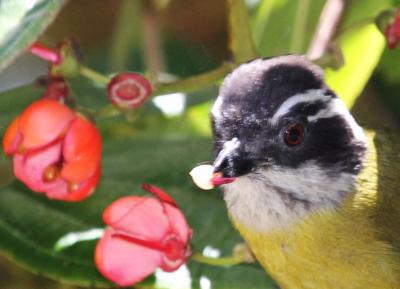Flowers used to come with understood meanings. Marigolds were for the jealous and aggrieved; ambrosias a sign of love returned. Dumas fil’s heroine in Camille carried white camellias when in the mood for a tryst; red ones said, “not tonight, sweetheart.”
Un-plucked flowers, however, don’t leave their intentions up to human interpretation. They have evolved highly specific characteristics to ensure that whoever comes calling will help them bear fruit. A newly discovered pollination mechanism in the flowers of the South American Axinaea genus of shrubs, described in Current Biology, exemplifies this evolutionary ingenuity. These Andean blooms rely on birds to spread their pollen, and they have an elaborate floral architecture to make this happen.
Bird pollination is uncommon for plants of the Melastomataceae family to which Axinea belongs: Bees pollinate 98 percent of them. But ornithophily—as bird pollination is called—is known to occur in more than 500 genera of flowering plants. Many of them grow on mountainsides: Few bees buzz in high altitudes and windy conditions. Birds are more reliable when it rains, and they fly farther, potentially pollinating within a greater range. Research suggests that bird-pollinated plants in these regions are more successful.
But blossoms that are inviting to birds are harder to make than ones that attract bees. They have to offer more food energy (which usually means more nectar), taking more of a plant’s resources. They must be shaped to be reachable to a bird’s beak but protected against nectar poaching by other animals that will not help them breed. Bird-pollinated flowers are often bigger than bee-pollinated ones, with complex structures to heighten allure and easy (but not too easy) access: tubular blossoms if hummingbirds are likely to hover next to them or growing in clusters if frequented by perching birds. These traits have emerged independently in many plants. Botanists think most of these species adapted from first being bee-flowered to bird-flowered ones when the latter proved advantageous for their habitats.
Axinaea has evolved a unique anatomy to maximize pollen delivery by the birds that visit it, as Agnes Dellinger of the University of Vienna and her colleagues observed. Their cameras captured how some species of tanagers, ubiquitous local song birds, alight next to Axinaea blossoms and pick out and eat the large, brightly colored stamens encased by the flower’s rosy-hued petals.

Copyright Agnes Dellinger
It seems odd for a flower to offer up its reproductive organs for consumption. But Dellinger found that in the case of Axinaea plants, this was perfectly reasonable: The stamen of their flowers is hollow and filled with air as well as pollen. When a bird plucks one from the flower’s base, squeezing the stamen’s stem, it causes the air within to expel the pollen like a bellow, blowing powder onto the bird’s head before the stamen is gobbled up.
The stamens are high in sugar, the researchers found, explaining why tanagers relish them. Moreover, only birds could harvest them: Vibrations or small disturbances were not enough to dislodge a stamen and activate its bellow mechanism. That means fewer opportunities for insects to plunder all their stored energy without contributing to the reproductive cause.
One hundred and fifty million years of evolution have made flowering plants astonishingly adept at dressing up their blooms for greatest effect, whether through size, shape, or color. (Ornithophilic flowers, for example, are more likely to be red—birds see the color well, but bees can’t perceive it.) But few designs measure up to the Axinaea’s sophistication: No other plant is known to have a flower with a bellow structure quite like it, nor a stamen meant for eating. An old-fashioned romantic might consider presenting a sprig if he is trying to coyly convey a message about his cleverness, adaptability, and commitment to reproductive success.
